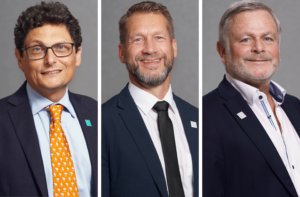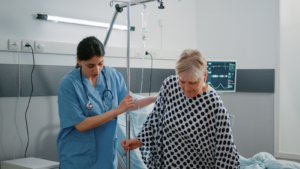Congress Newsletter 2022
From ESA to ESAIC passing through a pandemic. Past, present and future of a constantly evolving Society
Session ESAP3 took place on Monday 6 June, 1530-1630H, Amber 3
This session is available OnDemand on the Euroanaesthesia platform
One of the last sessions at this year’s Euroanaesthesia reflected on the evolution of the society from before and across the COVID-19 pandemic, including the name change from ESA to ESAIC. It included the perspectives of three presidents – Past-President Prof. Stefan De Hert (Belgium), who gave the ‘past’ talk; Immediate Past-President Prof. Kai Zacharowski (Germany) who gave the ‘present’ talk; and current President Pro.f Edoardo De Robertis (Italy).

(Left to right) – Prof. Edoardo De Robertis (ESAIC President), Prof. Kai Zacharowski (ESAIC Immediate Past-President), Prof. Stefan De Hert (ESAIC Past-President).
Prof. De Hert gave an overview of the amalgamation of the three former European anaesthesiology societies in 2005 that created the then European Society of Anaesthesiology (ESA), the name the society kept until 2020.
The ESA expanded substantially over the subsequent years, with a number of active members ranging between 4,000 and more than 7,500. The ESA congress Euroanaesthesia has become an attractive annual fixture for anaesthesiologists from all over Europe but also beyond gather to learn and exchange ideas. Euroanaesthesia attracts between 5,000 and almost 8,000 delegates. Even during the COVID pandemic, the virtual format was able to attract thousands of enthusiastic participants.
Prof. De Hert highlighted the success of the European Diploma of Anaesthesiology and Intensive Care (EDAIC) which has grown exponentially since 2005. Today more than 2,500 candidates take the part I examination and about 900 the part II examination. The EDAIC is now recognised worldwide as a proof of quality and expertise in anaesthesiology and intensive care. He also covered other areas that have developed extensively over the years: the European Journal of Anaesthesiology, the education department, the Clinical Trials Network, and of course the Helsinki Declaration on Patient Safety in Anaesthesiology in 2010.
“Part of improving patient safety is providing recommendations for good clinical practice. The ESAIC guidelines are published in the EJA. Up to now, 28 guidelines have appeared, eight are ongoing and there is a yearly call for 2 new guidelines,” explained Prof. De Hert. “Gender equity and sustainability are also important points of interest for ESAIC with dedicated committees working on these topics. The aim of the society is to strive for gender equity in all its committees and activities.”
He concluded: “History has shown that the amalgamation in 2005 of the three European anaesthesiology societies was a good and right decision. ESAIC now is the main European Society for Anaesthesiology and Intensive Care, dedicated to providing education and training to its members.”
Prof. Zacharowski spoke about the name change of the society from ESA to ESAIC, explaining the history of the decision and how anaesthesiology and intensive care have been, and will forever be, intertwined. Today, thanks to this name change, ESAIC appears on page 1, line 1 of any Google search, whereas the former ESA only finally appeared on page 21, due to having the same abbreviation as many other organisations such as the European Space Agency.
He also discussed the complicated history with another organisation working in the same area as ESAIC, the European Society of Intensive Care Medicine (ESICM), with whom relations have been up and down over the last decade, and the recent decision taken by both societies together with the Multidisciplinary Joint Committee for Intensive Care Medicine that intensive care medicine will no longer be pursued as its own speciality in Europe, but as a multidisciplinary competence.
As part of his time in office as society President, Prof. Zacharowski also introduced the system of Fellowship of ESAIC. Becoming a Fellow of the European Society of Anaesthesiology and Intensive Care (FESAIC™) is a prestigious honour awarded to healthcare professionals who have made a significant contribution to anaesthesiology and intensive care.
“To be a FESAIC indicates and proves an exceptional level of service to the Society and patients – from congress and research to education and advocacy – that distinguish FESAIC from their peers,” he explains. “The FESAIC title is now recognised throughout the anaesthesiology and intensive care community as a symbol of excellence.” (see https://www.esaic.org/fesaic for details on how to apply).
“Being a FESAIC is not only a recognition of your contribution to anaesthesiology and intensive care, but it also means that you belong to a dedicated group of professionals that demonstrate integrity and excellence in the care of your patients,” he said.
Continuing on the theme of visibility, he also highlighted the forthcoming first edition of the new society journal that will work alongside EJA, the European Journal of Anaesthesiology and Intensive Care, which was expecting 40 article submissions over its first year, yet has exceeded over 50 in the first six months of submissions.
The final section on the future was presented by ESAIC President Prof. Edoardo De Robertis, who said: “Considering the commitments of anaesthesiologists over the last few years it is now more important than ever to further develop the intensive care project and promote, sustain and spread the relevance of our complex speciality increasing ESAIC visibility and influence.”
He reflected that post-COVID events make one thing clear: even more than before, anaesthesiologists must break out of ‘silos’ and participate in the entire spectrum of patient care and organised medicine. He said: “Anaesthesiology will continue to be proactive, collaborative, team-based, and more than anything else, patient-centred. And the most successful groups will prove their value as perioperative and critical care coordinators.”
He echoed the comments of Prof. Zacharowski, saying that the first step to the future has been the name change to ESAIC, now including intensive care. He said: “Now we are adapting our structure to this, such as the reorganisation of scientific sub-committees. Further, for several decades we have focussed on the immediate postoperative period – now, we need to expand that period well into both the pre-operative and post-operative periods of care.”
Prof. De Robertis concluded that the pandemic has demonstrated “our resilience, our capacity to rise above the challenge, and our determination to never give up”. He explained: “This COVID-19 pandemic has put us in the spotlight and we have gained self-confidence and authority, but we have also highlighted the challenges ahead. As a society, we in ESAIC need to work on our ability to interconnect, become lean, and work on the sustainability of all our activities. We need to implement our capabilities, skills and agile organisation so that we continue to improve how ESAIC delivers, interconnects and creates value for our members.”
Read More of our special newsletter covering our congress.










